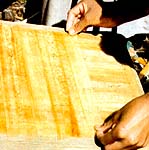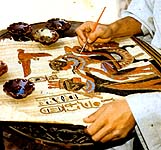History of Egyptian Papyrus Paper
5000 years ago the ancient Egyptians began to record their ideas, findings
and events of their daily lives in manuscript form, on Papyrus paper

Papyrus Plants
The most ancient writing material, the papyrus, was manufactured using an aquatic plant long-cultivated in the delta of the river Nile.
This graceful plant, Cyperus papyrus (family Ciperaceae) grows up to 15 feet high.
Its green, triangular stem bears long, sharp leaves, and radiating flower clusters, 10 to 20 inches long, which bloom at the tip.
The ancient Egyptians used the stem of the papyrus plant for many purposes, such as the making of cords, mats, sail, cloth, and most of all the parchment like paper, papyrus.
The ancient Greeks and Romans adopted this writing material.
It was used for the making of books, in scroll or roll form, and also for legal documentation and correspondence.

Cutting Papyrus Stem
The Roman writer, Pliny the Elder, left a detailed account of the manufacture of papyrus.
The outside, fibrous layer of the stem is removed, leaving the inner portion, the white pith, which is sliced longitudinally into strips.
The strips a placed side by side, in an alternating horizontal and vertical pattern, on a flat stone, then soaked in water and pressed under a heavy stone for 21 days.
The juice of the plant acts as an adhesive that bonds the strips together forming a sheet, which is finally hammered, and dried in the sun.

Making Egyptain
Papyrus Sheet of Paper
Papyrology is the science of reading, interpretation, and care of ancient documents written on papyrus.
The oldest papyri date from about 3000 BC
Some of the most important ancient Egyptian papyri discovered are: the Rhind (mathematical) papyrus, the Edwin Smith (surgical) papyrus, and the Turin papyrus.
Numerous literary compositions dating from Hellenistic and Roman times, written on papyrus, in Egyptian demonic script, Greek, or Latin ha been collected in the late 18th and early 19th centuries.
They have become invaluable sources of information on about the ancient Mediterranean world, and an important aid to the study of ancient religions, and classical literature.
One of the most interesting findings was a manuscript of the Constitution of Athens by Aristotle, discovered by an American missionary in 1890.
In the late 1940s new biblical manuscripts were discovered on papyrus scrolls, in the Dead Sea area.

Egyptain
Papyrus Painting
Our large line of hand painted art on genuine papyrus comes in over one hundred designs,
and in a variety of colors and sizes, all are suitable for framing (We strongly recommend you to select your own favorite style of frame).
A certificate of authenticity, which guarantees that this papyrus is made in Egypt, using real papyrus plants and ancient techniques, accompanies each piece.
The art is hand painted in the purest tradition of the paranoiac art by Egyptian fine artists, who accurately reproduce art pieces found in ancient temples and pyramids.







